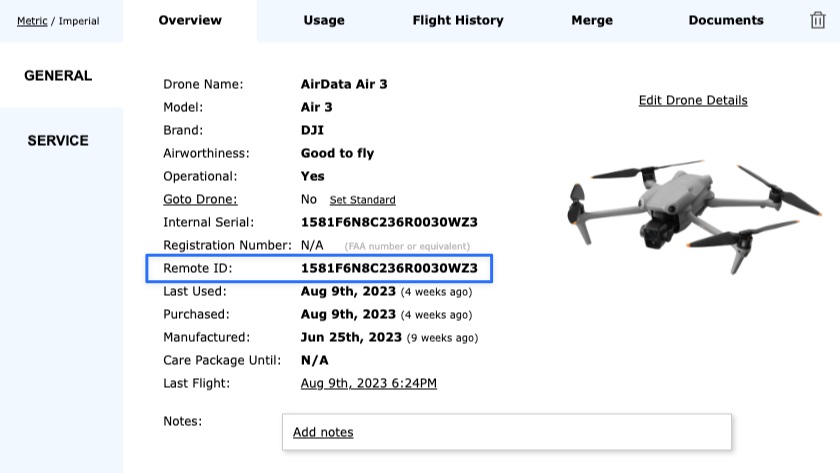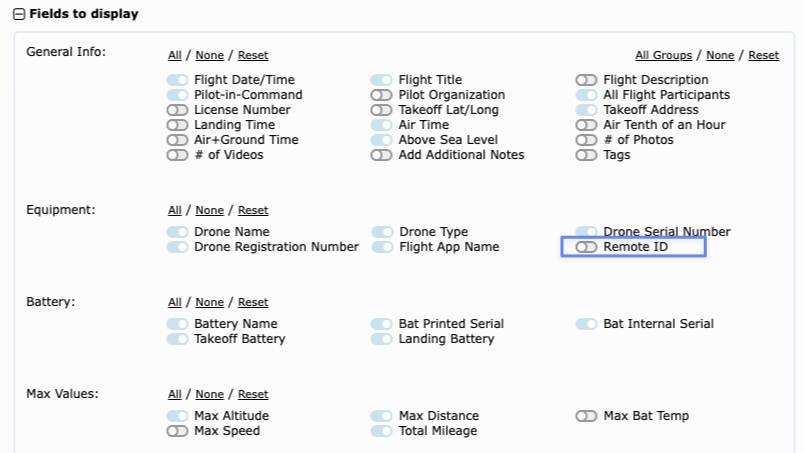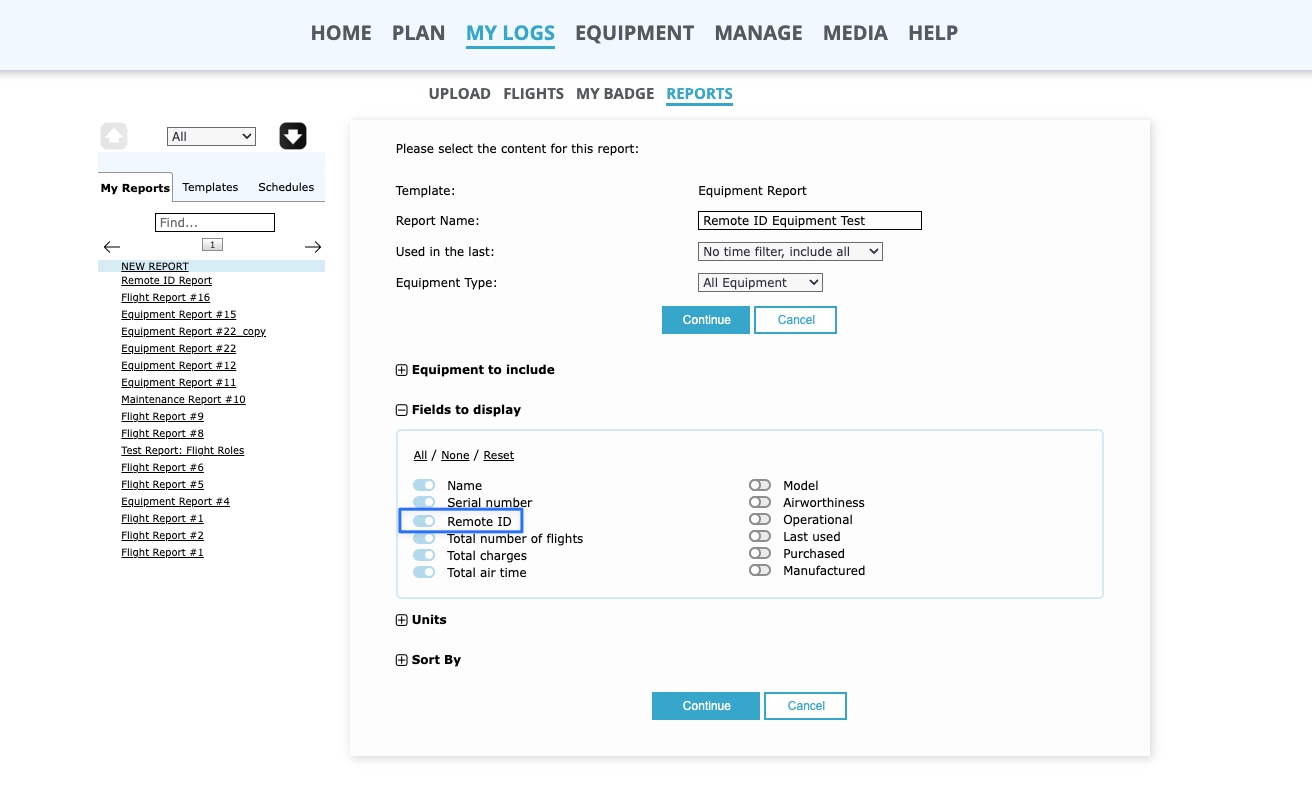Remote ID
| Feature availability | | | | | |
|---|
Managing Remote ID in AirData
You can manage Remote ID information for your aircraft using AirData’s equipment management features. Users of the Pro and Enterprise plans will also be able to generate flight reports that include Remote ID information.
AirData users will be able to view their Remote ID info in the equipment profiles under Equipment -> Drones.

For many aircraft, their Remote ID is the same as their Internal Serial Number.
If you have an aircraft that was not manufactured with Remote ID capabilities, you can make your aircraft compliant by adding a Remote ID broadcasting module. AirData users will be able to view their Remote ID info in the equipment profiles under Equipment -> Drones.
Reporting on Remote ID in AirData
| Feature availability | | | | | |
|---|
The Remote ID field can be added to Standard Flight Reports.
To add Remote ID to your Standard Flight Report, head to MY LOGS -> REPORTS to create a new Standard Flight Report.
Then, scroll down to "Fields to Display" -> "Equipment" and toggle the "Remote ID" field.
To see more detailed instructions on creating Flight Reports, please see our Reports help section: https://app.airdata.com/wiki/Help/Reports

The report's PDF output will look similar to the image below.

Equipment Reports
| Feature availability | | | | | |
|---|
Enterprise users also have the ability to add the Remote ID field to Equipment Reports.

Remote ID FAQ
What is Remote ID?
A number of aviation and transport authorities around the world have mandated its use or are currently exploring the implementation of Remote ID mandates.
Specific Category regulations: https://www.easa.europa.eu/en/domains/drones-air-mobility/operating-drone/specific-category-civil-drones
AU CASA: The Australian Civil Aviation Safety Authority is currently discussing the creation of a future Remote ID mandate. "The Aviation White Paper committed to undertake a Policy Impact Analysis for a future Remote ID mandate in Australia."
Flight Rules for Unmanned Aircraft: https://www.mlit.go.jp/en/koku/uas.html
Getting started with Remote ID: https://www.faa.gov/uas/getting_started/remote_id
Remote ID Executive Summary: https://www.faa.gov/sites/faa.gov/files/uas/getting_started/remote_id/RemoteID_Executive_Summary.pdf
Which aircraft currently have built-in Remote ID capabilities?
The FAA requires manufacturers to submit a Declaration of Compliance for aircraft models that have built-in Remote ID capabilities. You can view the list of aircraft with Declarations of Compliance at the link below. You can search for your aircraft using its Remote ID serial number.
Find your aircraft Declaration of Compliance: https://uasdoc.faa.gov/listDocs
FAA Remote ID Standard Infographic: https://www.faa.gov/sites/faa.gov/files/uas/getting_started/remote_id/industry/Remote_ID_Standard.pdf
What can I do if my aircraft does not have Remote ID capabilities?
Some manufacturers are releasing firmware updates to their older aircraft models that will enable Remote ID broadcasting for those aircraft.
If your aircraft will not have Remote ID capabilities by September 16, 2023, you may need to purchase a separate Remote ID module. A Remote ID module is “a device that broadcasts identification and location information of the drone and take-off location in accordance with the Remote ID rule”. These devices can be attached to your aircraft and will satisfy the FAA’s Remote ID requirements.
FAA Remote ID Toolkit: https://www.faa.gov/uas/getting_started/remote_id/Remote-ID-Toolkit-main.pdf
FAA Remote ID Broadcast Module Infographic: https://www.faa.gov/sites/faa.gov/files/uas/getting_started/remote_id/industry/Remote_ID_Broadcast_Module.pdf
Which aircraft and pilots are exempt from Remote ID requirements?
There are some exemptions from Remote ID requirements.
Remote ID is a requirement for unmanned aircraft that require registration with the FAA. Any aircraft that do not require registration are exempt. This typically applies to aircraft under 0.55 lb/250 g in weight.
FAA Page on How to Register Your Drone: https://www.faa.gov/uas/getting_started/register_drone
Pilots flying in FAA-Recognized Identification Areas (FRIAs) will not be required to have Remote ID capabilities. These are specially designated areas for unmanned aircraft flying and are typically associated with educational institutions or community organizations.
FAA Page on FAA-Recognized Identification Areas (FRIAs): https://www.faa.gov/uas/getting_started/remote_id/fria
What is the FAA’s Part 89?
The FAA’s Part 89 is a document that outlines regulations for the “Remote Identification of Unmanned Aircraft”. This is found under the FAA’s Title 14 - Chapter I - Subchapter F.
Title 14 Aeronautics and Space - Chapter I - Subchapter F: https://www.ecfr.gov/current/title-14/chapter-I/subchapter-F
Part 89—Remote Identification of Unmanned Aircraft: https://www.ecfr.gov/current/title-14/chapter-I/subchapter-F/part-89
Means of Compliance Process for Remote Identification of Unmanned Aircraft: https://www.faa.gov/documentLibrary/media/Advisory_Circular/AC_89-1.pdf
Does my aircraft manufacturer offer native Remote ID support?
Most major drone manufacturers marketing their products in the US have already announced or implemented changes for Remote ID support. Below are announcements and articles from some major brands.
DJI: https://enterprise-insights.dji.com/blog/remote-id-dji-enterprise-drones
Autel: https://www.autelrobotics.com/download/582.html
Parrot: https://www.parrot.com/us/newsroom/parrot-freeflight-6.7.4-update
Teal Drones: https://redcat.red/press_releases/red-cats-teal-2-suas-receives-remote-id-certification-from-faa/
| Comment Section | Sort by:
|













Please login to add a comment
Thank you for posting this question.
AirData's Remote ID features are designed to accommodate a broad range of regulatory requirements, including the EASA's.
If the aircraft has built-in Remote ID broadcasting, that information should be available in their flight logs and will be displayed on AirData.
For drones without built-in Remote ID capabilities, the EU EASA does allow the use of Remote ID upgrade modules, as described here: easa.europa.eu apologies if this help article is not clear regarding our support for different sets of Remote ID regulations.
We will update the article to address this.
Thank you.
Best Regards,
Tom
AirData Support